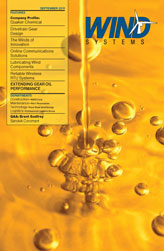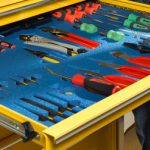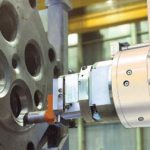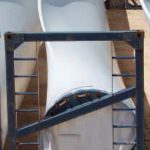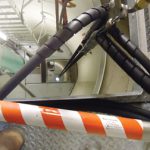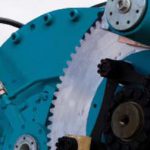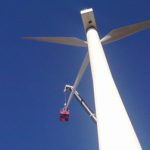The standard gear oil textbook has been ripped up and rewritten following recent advances in wind turbine technology. The loads on the lubricant are now so great, the operating conditions are so harsh, and the need for reliability is so vital that the lubricants—like other aspects of wind turbine technology—have become increasingly sophisticated. The development of these fluids is pushing at the boundaries of known science.
At Shell we can offer a unique insight into the challenges of developing a lubricant that meets the requirements of the wind turbine industry. Creating a next-generation gear oil can take up to five years at a cost of millions of dollars. It has to undergo more than 300 separate laboratory and rig tests before it is even considered for a field trial. These tests measure a multitude of parameters such as wear protection, load carrying capability, shear stability, resistance to foaming, filterability, and micropitting protection. Figure 1
Clearly, developing a lubricant that meets the exacting standards of the wind turbine equipment manufacturers is a substantial challenge, but it has led to a wide range of highly advanced lubricants that are used across other industrial sectors. The technological advances we make in developing these lubricants are ultimately benefiting users in sectors such as mining and manufacturing. When a customer selects a lubricant for their operations that they know meet the requirements of the wind turbine industry, they can be sure that it will deliver value to their operations, whatever the challenges.
The wind turbine sector is effectively the space race of the power sector, with innovations and advances appearing at an astonishing rate. The lubricants are an integral part of this development cycle.
Wind: The Fastest Growing Power Generator
The wind turbine industry is the world’s fastest-growing option for power generation. The annual growth rate is at some 25 percent through the on- and offshore developments being pursued all over the world. Europe and Asia are driving this growth along with the United States, where wind power contributes 42 percent of all new generating capacity. Global wind power capacity is expected to more than double between 2008 and 2013.
Wind turbine installations and structures are increasing in size to maximize power generation capacities: the turbines can stand up to 150m high and have a rotor span of 100m. In 1996 the average turbine rating was 600kW, but this is increasing rapidly and most new ones are about 2–3MW, with some at 5MW. Several companies and research programmes are even planning or investigating wind turbines of up to 10MW output or more. Figure 2
Such developments will help to maximize returns on investment and reduce the cost of producing electricity from wind power. However, this expansion in generating capacity introduces various challenges for the turbine and component manufacturers, wind farm operators, and service companies that need to ensure that the equipment works reliably and requires minimal maintenance. A modern wind turbine is expected to generate electricity continuously when wind speed is available, to operate unattended, and to have extremely low maintenance requirements.
This is a complex technical challenge. The wind turbines sit on top of high columns, and many installed units have to be robust enough to withstand both very high and very low temperatures, from sub-Arctic cold to blistering desert heat, as well as salt-laden winds and rain. The rotors can also be static for periods of time, all of which place specific challenges on the lubricants. Figure 3
Designed to Meet Challenges
The main gearbox, which drives the generator and is the heart of most wind turbines, comes under enormous strain. Reliability is imperative. A major reliability concern is gearbox micropitting, which results from factors such as case hardening and the surface roughness of the gear teeth, as well as inappropriate lubricant selection and application.
Given the gearbox’s size, the lubricant’s short recirculation times and the potential for air entrainment in the system, good air-release and anti-foaming characteristics are vital properties for the gear oil. Excessive foaming can cause the oil level to rise above the maximum, which may result in unplanned turbine shutdown and loss of power to the grid. Figure 4
To deal with these challenges Shell Lubricants has developed Shell Omala S4 GX 320, a synthetic gear oil that provides excellent performance in the areas requiring added protection against common failure modes, including micropitting and bearing wear. The product offers distinct advantages over conventional gear oils, particularly for product life. Field trials have shown it has up to four times the oil life of conventional mineral oil-based products, which enables the intervals between maintenance to be extended. The lubricant also gives excellent wear protection and is designed to reduce micropitting wear on gear teeth, which helps to extend the life of gearbox components and prolong operation.
Shell Omala oils have delivered value to customers across a wide range of industries. For instance, one customer in an industrial application reports virtually eliminating gearbox failures and saving over $50,000 a year by switching to Shell Omala S4 GX. The oils have also extended oil-drain intervals: some equipment manufacturers approve Shell Omala S4 GX for four-year drain intervals, and some customers have extended their oil-drain intervals by up to five times.
However, a wind turbine’s lubricant-related challenges are not limited to the gearbox. The massive blades of a wind turbine are supported using grease-lubricated blade bearings that, if insufficiently lubricated, can fail through fretting and false brinelling. Again, the lubricant must be able to operate at temperature extremes and have corrosion-protection qualities. Figure 5
As a result, Shell formulated Shell Rhodina BBZ grease using experience gained from developing greases for helicopter rotors. This is designed to protect bearings against fretting corrosion, moisture contamination, and false brinelling at temperatures as low as –55ºC.
Shell Rhodina BBZ is establishing a track record with both customers and major wind turbine manufacturers. It is lubricating the blade bearings of many wind turbines globally through our listings with leading blade bearing suppliers such as IMO, Liebherr, Rollix and Rothe Erde, and wind turbine manufacturers including Vestas, Acciona, Gamesa, Dongfang New Energy Equipment, Sinovel Wind Group, and Siemens Wind Power.
Operating in Extreme Conditions
For wind turbines that operate in ultra-low temperatures, Shell Tellus S4 VX is recommended for the hydraulic systems. Through its specially selected base fluids, it has the widest operating temperature range in the Shell Tellus range, so it can be used in wind turbines that operate in extreme climates.
Operators that need to run hydraulic equipment in extreme cold have benefited from using Shell Tellus S4 VX because it can help to deliver high levels of equipment availability. Start-up is easy, and maintenance requirements are reduced. Crucially, it also helps to improve efficiency because the energy losses through pumping hydraulic fluid at low temperatures are controlled. The product is recommended or listed by Svendborg Brakes and by wind turbine manufacturers including GE Wind Energy, Voith Turbo, Vestas, Dongfang Wind Turbines, Sinovel, REpower, Nordex, and DHI.
The yaw gear, which is mounted on the tower and enables the nacelle to rotate, is also subjected to huge forces. For these applications Shell developed Omala S4 WE, an advanced, synthetic industrial-gear lubricant formulated using specially selected polyalkylene glycol base fluids and additives. Shell Omala S4 WE offers outstanding lubrication performance under severe operating conditions, including improved energy efficiency in comparison to mineral-based products, long service life, and high resistance to micropitting. Figure 6
Accelerating Innovation
A recent report by the International Energy Agency (IEA) suggested a target of 12 percent of global electricity from wind power by 2050, and said that there is no fundamental barrier to achieving or even exceeding this goal. It expects investment costs to continue decreasing: by 23 percent for onshore installations and 38 percent for offshore projects by 2050.
Nevertheless, the IEA counsels that increased efforts in wind technology research and development are essential. That is why Shell is working hard to develop lubricants that will meet the industry’s challenges, and it is not working in isolation. It collaborates with leading wind turbine manufacturers, component suppliers, and industry associations to understand emerging lubrication needs, the rapidly changing industry, and manufacturers’ specifications.
Every component in a wind turbine is technically challenged, pushed to the limits and operating on the edge of known science, and the lubricant is no different. Equipment design and the lubricant’s capability will be key to the larger, more-reliable units that the industry is striving for. Shell is committed to facilitating this by advancing the state of the art in lubricant technology.



















